TIMENIX
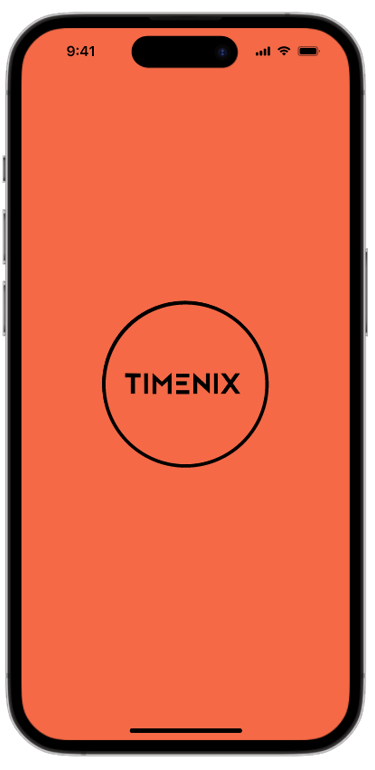

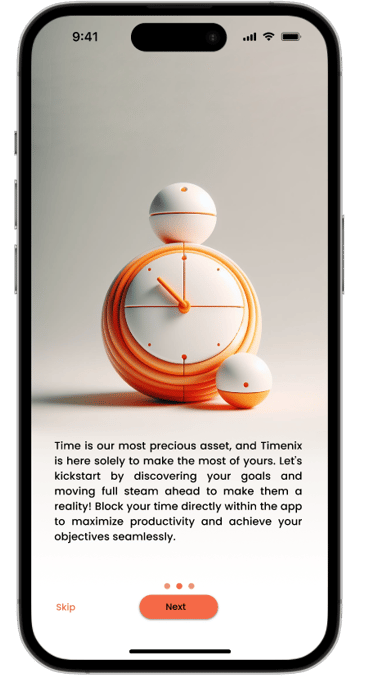

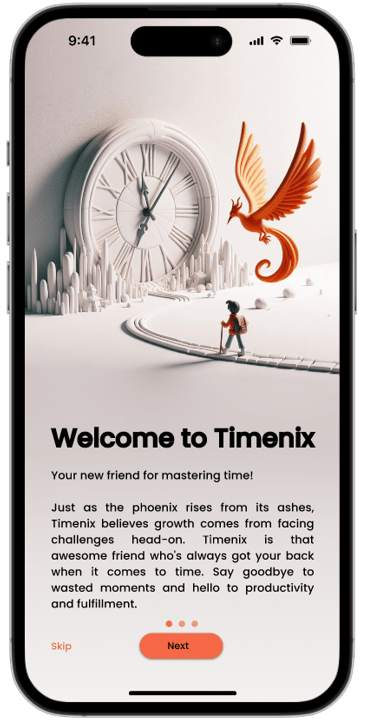

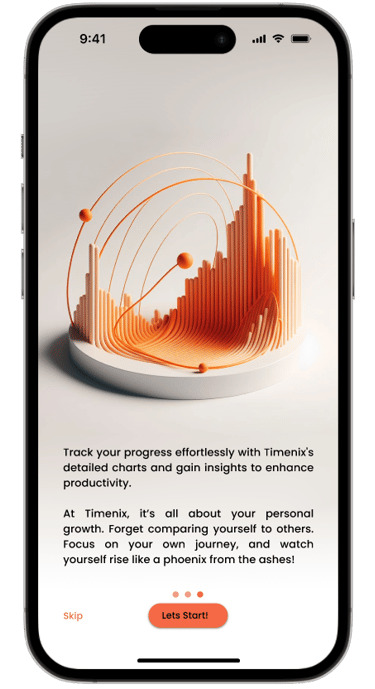

In 2025, TIMENIX has been accepted for the Cambridge Accelerate Program at the Judge Business School, University of Cambridge.
In today's world, many of us do not feel in control of our attention, and this feeling of constant distraction can lead to a lack of fulfillment. Modern technology, like social media, is designed to steal your attention because our attention has value! This has led to a crisis of attention deficit. Our interactive technology, Timenix, can be your dedicated guide. Timenix symbolizes rebirth and transformation in your relationship with time and cares for you through an easy-to-use phone application. Timenix is the friend who: Helps you accurately reflect on your habits with the help of AI, Gives you the tools to avoid distractions in the present by blocking your time, Provides the most effective techniques, backed by science, to become your best self in the future.
Difficulty in Concentration and Time Management: Distractions on electronic devices Attention deficit challenges Information overwhelm Problems with Existing Productivity Tools: Overly complex Distracting features Lack of a holistic approach to attention Ineffective tools
The app offers a clean, intuitive interface that tracks productivity and analyzes various factors, such as sleep and exercise, to provide personalized insights based on your behavior. This holistic approach ensures users receive meaningful support tailored to their unique needs. In developing Timenix, this project's primary aim was to simplify the user experience and streamline functionality.
We focused on four core objectives: simplicity and minimalism, efficiency, seamless integration, and personalized insights. The app's design prioritizes straightforward navigation and ease of use, minimizing the time and clicks required for operation. Most importantly, the app acts as a supportive friend for individuals struggling with concentration issues. Leveraging insights from neuroscience and psychology, it offers personalized advice, caring about users' time and well-being while empowering them to enhance productivity.
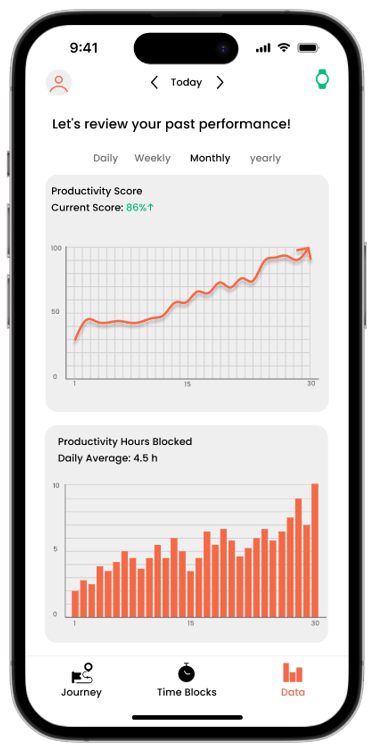

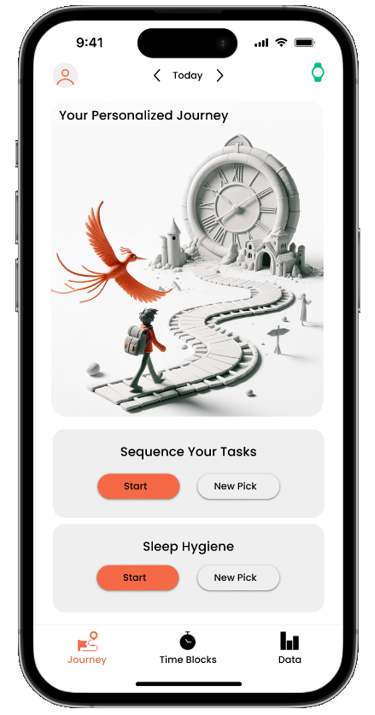

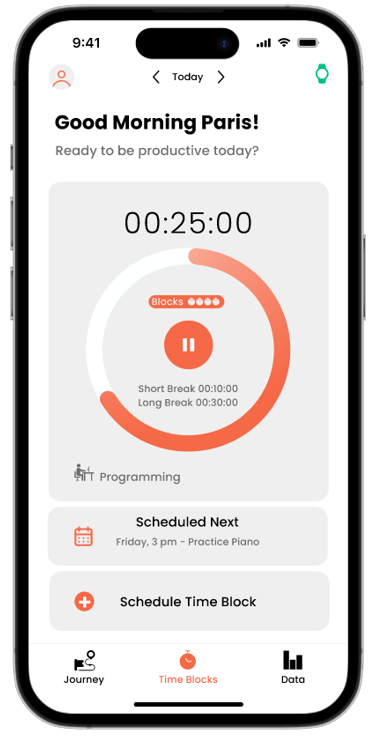

Project Overview
What is Timenix?
Timenix is an AI-powered productivity sidekick that helps users reclaim their focus, reduce distractions, and build better habits. It is not quite a coach. Not just a friend.
Timenix: The sidekick you didn’t know you needed...
on your phone, on your wrist... and always on your side.
Rather than offering rigid schedules or generic advice, Timenix adapts to users’ personal context through conversations, reflections, and daily check-ins. It is a companion that evolves with you. Supportive, intelligent, and always just one tap away.
My Role:
Product Designer (UX/UI)
Responsible for product specification, user experience design, interface design, and prototype development using Figma and FlutterFlow.
Problem Statement
In today’s world, maintaining focus has become increasingly difficult. Distractions, fragmented schedules, and a constant stream of digital interruptions make it challenging for individuals to remain grounded in their goals.
Traditional productivity tools are often rigid and impersonal. They focus on time tracking but fail to understand context or adapt to individual behavior.
Hiring a personal productivity coach could provide tailored guidance, but the cost makes this solution inaccessible for most people.
There is a need for a more human, affordable, and intelligent approach. A system that does not simply track habits, but actually supports behavior change.
This is the space Timenix is designed to fill.
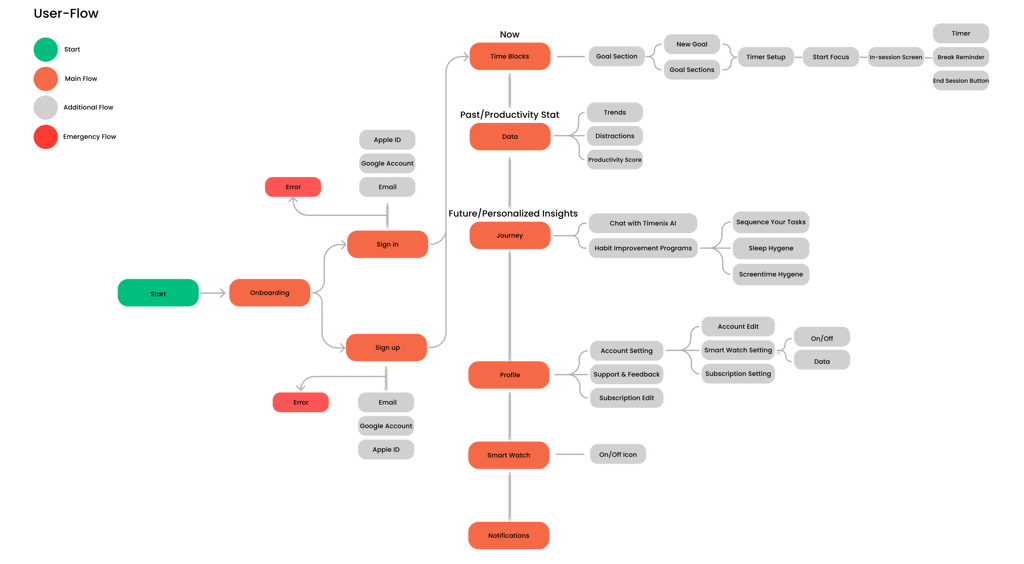

Proposed Solution (MTP – Minimum Testable Product)
Timenix offers a lightweight, accessible version of personalized productivity support powered by artificial intelligence.
It is designed to feel less like a tool and more like a companion. Not a coach. Not a friend. A sidekick. Present, supportive, and context-aware.
The Minimum Testable Product (MTP) includes:
A conversational chat interface with five selectable modes
A Pomodoro-style focus timer with distraction logging
Manual tracking for mood, sleep, caffeine, exercise, and environment
Daily habit insights generated through artificial intelligence
End-of-day reflection and productivity rating
Session trend visualization and focus statistics
Lightweight data management tools for transparency and trust
The goal of the MTP is to test usability, engagement, and the perceived helpfulness of the AI sidekick model in daily life.
Key Screens and Features
Page 1 – Speak to Timenix (Home)
Chat interface with five structured conversation modes:
Morning Planning
Daily Update
Self-Reflection
Clarity Booster
Free Chat
Floating chat button for quick assistance
Voice and text input support
Page 2 – Time Blocks
Large, single-tap Start and Stop button
Minimalist timer display
Distraction logging post-session
Auto-end toggle for hands-free focus sessions
Settings for session length and notifications
Designed for one-handed use
Page 3 – Data and Session History
Overview of session statistics
Logged distractions, moods, and focus ratings
Simple controls for data encryption, download, and removal
Page 4 – Journey
Narrative-based view of the user’s progress
Personalized suggestions and performance feedback
Progress bars and visual indicators of improvement
UX Design Goals
Reduce friction through a simplified interface and helpful guidance
Offer emotional support by creating a conversational and responsive experience
Ensure quick engagement through mobile-friendly and accessible design
Build trust and retention through adaptive feedback and behavioral insights
Provide consistent access to assistance through a persistent floating chat button
Platforms and Tools
The following platforms are used for design, development, and documentation:
Figma – Interface design and prototyping
FlutterFlow – Low-code development and Firebase integration
Firebase – Backend storage for user data and session logs
OpenAI API – Natural language processing for AI conversations and recommendations
All tools were selected for their cost-efficiency, flexibility, and ease of integration with testing workflows.
Success Metrics
The primary objective is to determine whether Timenix can function as a daily sidekick, rather than a traditional app. Success is defined by consistent use, emotional engagement, and user-perceived value.
Quantitative Metrics:
Number of active users
Daily retention rate
Average session duration
Frequency of chat interactions
Use of voice input versus text input
Qualitative Feedback:
Did the user feel supported by the AI?
Were insights relevant and personalized?
Was the interface clear, calming, and easy to use?
User feedback and behavior will guide future iterations, including deeper personalization, wearable integration, and expanded habit analytics.
User Testing Methodology
The primary goal of user testing for the MTP version of Timenix is to validate usability, emotional resonance, and practical effectiveness in real-world contexts. The testing process combines live app usage with pre- and post-engagement surveys to gather both behavioral and qualitative feedback.
A. Testing Objectives
Evaluate ease of interaction with core features (chat, timer, habit input)
Measure emotional experience during and after use
Assess user retention and repeated engagement
Determine the perceived value of AI-generated insights
Test the effectiveness of the voice-input feature for productivity conversations
B. Key Assumptions to Validate
Users will prefer one-handed, quick interactions for daily productivity tracking
AI-generated insights will feel personal, actionable, and not repetitive
A sidekick-style interface will result in higher emotional engagement than traditional apps
Voice interaction will increase app stickiness and convenience
Simple mood and distraction logging will be easier to adopt than task management systems
C. Testing Tools and Channels
Live user testing on mobile and web through FlutterFlow’s deployed build
Behavioral tracking using Firebase analytics
Voice usage metrics and token tracking from OpenAI integration
Pre-test and post-test surveys delivered via Google Forms
Optional 1-on-1 interviews with selected users for deeper insight
D. User Interaction Metrics
Daily Active Users (DAU)
Average session duration
Number of chat conversations per user
Frequency of feature use: timer, distraction logging, daily reflections
Token count per interaction (to measure chat depth)
E. Feedback Collection Metrics
Pre-Test: User productivity habits, challenges, and expectations
Post-Test: Perceived ease of use, clarity of interface, emotional satisfaction
Open-ended responses on what worked, what felt unnecessary, and what could improve
F. Success Indicators
If Timenix is effective, the following outcomes are expected during user testing:
At least 50 percent of test users return to the app after the first session
Over 70 percent complete a full focus session using the timer
Users rate insights from Timenix as “helpful” or “very helpful” in post-test feedback
Voice interaction is used by at least 40 percent of test users
Users describe the app as “supportive,” “motivating,” or “encouraging” in open comments